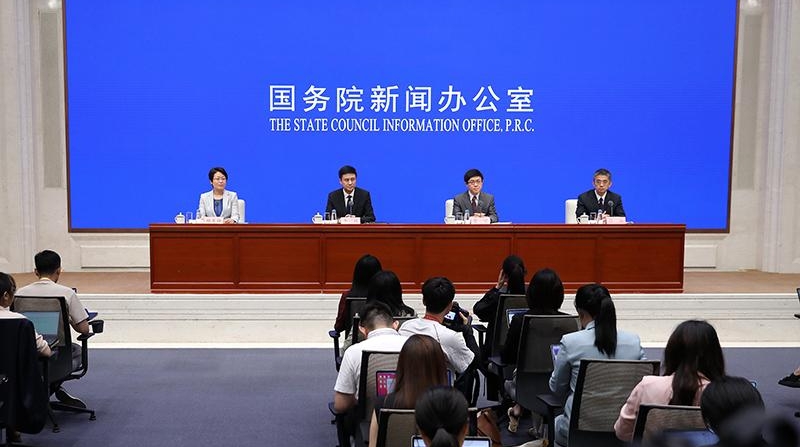Speakers:
Mr. Li Bin, deputy administrator and spokesperson of the State Administration of Foreign Exchange (SAFE)
Mr. Jia Ning, director general of the Balance of Payments Department of SAFE
Mr. Xiao Sheng, director general of the Capital Account Management Department of SAFE
Chairperson:
Ms. Xing Huina, deputy director general of the Press Bureau of the State Council Information Office (SCIO) and spokesperson of the SCIO
Date:
July 22, 2025
Xing Huina:
Ladies and gentlemen, good afternoon. Welcome to this press conference held by the State Council Information Office (SCIO). This is a regular briefing on China's economic data. Today, we are joined by Mr. Li Bin, deputy administrator and spokesperson of the State Administration of Foreign Exchange (SAFE), who will brief you on China's foreign exchange receipts and payments data in the first half of 2025 and take your questions. Also attending today's briefing are Mr. Jia Ning, director general of the Balance of Payments Department of SAFE, and Mr. Xiao Sheng, director general of the Capital Account Management Department of SAFE.
Now, I will give the floor to Mr. Li for his introduction.
Li Bin:
Good afternoon, everyone. First of all, I would like to express my heartfelt gratitude for your ongoing interest in and support for the administration of foreign exchange. I would like to take this opportunity today to first introduce the relevant situation of China's foreign exchange receipts and payments in the first half of 2025, and then answer your questions together with my colleagues.
Since the beginning of 2025, the external environment has become more complex and volatile, unilateralism and protectionism have risen, the momentum of global economic and cross-border trade growth has weakened, and international financial market volatility has increased. China has accelerated the implementation of more proactive and effective macro policies, focused on expanding domestic demand, and effectively responded to external challenges, while the overall economic operation has been stable and improving, with high-quality development continuously consolidated. The foreign exchange market has operated smoothly, showing strong resilience and vitality and outperforming market expectations. There are five characteristics:
First, the scale of foreign-related receipts and payments has steadily increased, when viewed from the perspective of total volume. In the first half of the year, the cross-border revenue and expenditure of non-banking sectors, including enterprises and individuals, totaled $7.6 trillion, a year-on-year increase of 10.4%, setting a new historical high for the same period, among which the proportion of RMB in cross-border receipts and payments reached 53%. In the first half of the year, foreign exchange settlement and sales by banks totaled $2.3 trillion, a year-on-year increase of 3%, the second highest in history for the same period. This data indicates that the cross-border trade and investment activities of the country continued to remain active.
Second, cross-border capital continued to show a net inflow, when seen from the gap between revenue and expenditure. In the first half of the year, China's non-banking sectors, including enterprises and individuals, recorded a net cross-border capital inflow of $127.3 billion, continuing the net inflow trend since the second half of the previous year, with a quarter-on-quarter increase of 46% in the second quarter. In terms of categories, the net inflow under goods trade remained high in the first half of the year, foreign capital increased holdings of domestic stocks and bonds, and the situation with service trade and the repatriation of profits by foreign-funded enterprises was stable and orderly.
Third, the supply and demand of the Chinese foreign exchange market has maintained a basic equilibrium. In the first half of the year, the bank foreign exchange settlement deficit was $25.3 billion, but there were significant changes between months. Specifically, the foreign exchange settlement and sales were in deficit in January, tended to be basically balanced from February to April, and turned into a surplus in May and June, with the trading behavior of enterprises and individuals being generally rational and orderly. In the first half of the year, the forex settlement rate, which measures the willingness to settle foreign exchange, was 60%, remaining stable year on year; and the forex sales rate, which measures the willingness to purchase foreign exchange, was 65%, down 3 percentage points year on year.
Fourth, forex transactions remained active. In the first half of the year, total transaction amount in the domestic yuan forex market reached $21 trillion, up 10.2% year on year. Specifically, the volumes of spot and derivative transactions were $7.4 trillion and $13.6 trillion, respectively, accounting for 35% and 65% of the total, respectively.
Fifth, the scale of China's foreign exchange reserves remained stable. At the end of June, the balance of foreign exchange reserves stood at $3.3174 trillion, an increase of $115.1 billion from the end of 2024. In the first half of the year, non-U.S. currencies appreciated against the U.S. dollar, and global financial asset prices generally rose. Under the combined effect of factors including exchange rate translation and asset valuation changes, the scale of China's foreign exchange reserves remained stable while increasing.
Overall, in the first half of the year, China's foreign exchange market effectively mitigated risks from external shock and demonstrated generally stable performance. Next, SAFE will firmly implement the decisions and arrangements of the CPC Central Committee and the State Council, adhere to the general principle of seeking progress while maintaining stability, balance development and security, and continuously improve the "more convenient, more open, more secure, and smarter" foreign exchange management system to promote high-quality economic development and high-standard opening up. That concludes my brief introduction on the foreign exchange receipts and payments in the first half of the year. Next, my colleagues and I are happy to answer your questions. Thank you.
Xing Huina:
The floor is now open for questions. Please identify the news outlet you represent before raising your questions.


 Share:
Share: 




 京公网安备 11010802027341号
京公网安备 11010802027341号